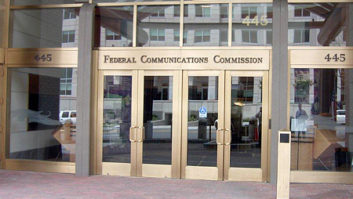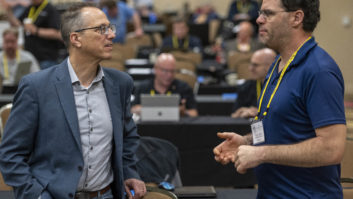In the shimmering heat of the desert morning, NPR reporter Ivan Watson prepares his recording equipment for another day. His beat for the next month is Iraq. His mission is to tell the story in sound.
Ivan checks his Sony MZ-B100 MiniDisc recorder, handy because it uses a single AA battery. The recorder comes to life, clicking and whirring, LEDs flashing. His cables are in good shape, only slightly worn from the heat and sand and a little scuffed from rubbing against the boxes and sides of the truck transport that he rides when traveling to more dangerous locations.
The cursory equipment check complete, Watson clicks off the MiniDisc’s power and stuffs his two recorders, an Audio-Technica AT835 short shotgun microphone, ElectroVoice EV-50 microphone, Sony 7706 headphones, MiniDiscs, notepad, pens, extra batteries and water into a canvas tote.
Today he’s in Najaf, covering the confrontation between the Iraqi government and the forces of radical Shi’ite cleric Muqtada al Sadr. There was gunfire from the insurgents in a building near the holy Imam Al Ali Shrine. Earlier in the day, the Army dropped him off at the wrong location, so he and other journalists rode to Najaf in an Army ammunition truck sitting on boxes of grenades, ammunition and mortar rounds.
Here it comes
In Record Central 1, at NPR’s Washington headquarters, technician Stu Rushfield answers Watson’s telephone call. “Yep, just a minute,” Rushfield says into the phone. “I’ll get set up.”
He turns to the rackmounted Telos Zephyr ISDN codec, quickly sets it for MPEG Layer 2 Mono, and waits for its familiar “Brrrrt-Brrrt” ring. He presses the Yes button to accept the call, and a 12-digit caller ID number appears.
It’s Watson connecting from Najaf using a Nera World Communicator 64KB satellite phone and GlenSound GSGC-4 codec. He’s dubbed his actualities and ambience into his laptop an hour before, and using CoolEdit2000, edited them into a coherent string of cuts ready for feeding through the laptop’s analog output and into the GlenSound’s line input.
“OK, let’s get levels,” Rushfield says briskly.
He knows Watson’s piece is first in the show, and it’s now a little after 1500 ET (3 p.m.), about an hour until air. Watson opens the mic input of the GlenSound and reads a few lines of his voice tracks and inquires, “How’s that for level?” Rushfield glances again at the PPM meters on his Pacific Recorders console and sets up a new Dalet recording session with a couple of mouse clicks.
“Good level, and we’re recording,” Rushfield squawks down the ISDN connection. He starts the Dalet record session as well as an analog 7.5 ips backup recording. Watson slates his piece and begins reading his tracks; each is slated with a simple mixing instruction (“…and bring the sound of the mortar attack under and then I come in … in three, two, one…”).
Watson finishes his tracks, then feeds the edited actualities and sound to Record Central 1 before preparing for the following day. It’s already 2300 (11 p.m.) in Najaf, and Watson’s planning to go on maneuvers with a U.S. Marine force early the next morning. Destination: unannounced.
Filling the gaps
It’s 1515 ET, and as Watson feeds the acts and sound bites to the Record Central, “All Things Considered” show director Bob Boilen is sitting in his office at his Dalet workstation, listening to Watson’s tracks to get a sense of the piece. Boilen is selecting “tease” cuts for the ATC billboard that will play exactly at 1600 ET.
Across the open ATC work area, Associate Producer Quinn O’Toole is sitting at his Dalet workstation, laying up and editing Watson’s tracks and the still-to-be-completed actualities and sound.
“You wanna quote?” He says with a wry smile, “It’s this: Dalet is great for letting me cut while the feed’s still in progress.”
He turns back to his screen, adjusts his headphones over just his left ear and deftly nudges the nondestructive edit points left, right; then, satisfied, he moves to the next edit. He has separated all of Watson’s tracks onto the first editing panel, leaving gaps where the actuals and sound will be laid in the subsequent editing panel below. A couple of mouse clicks adds the actuality file to the second editing panel, and O’Toole dissects its contents, copying and pasting each actuality where it belongs.
He glances at Watson’s script, sent by an Internet connection to the NPR corporate scriptwriting server, ENPS, and drags an actuality to later in the timeline. It’s about 1530 ET. O’Toole adds the piece’s ambience to the fourth editing panel and splays its contents until he find the muffled mortar round explosion. He drags it to align with a gap in the first editing panel and nudges Watson’s tracks closer. He’s still got a native speaker, and English translation to finesse on panels two and three, and quickly checks the lay up for the correct “feel.” The last thing he does is save this Edit Decision List before leaving his desk.
On the screen
It’s about 1540 ET, and ATC Technical Director Michael Cullen directs O’Toole to mix with an engineer in Studio 2B, already reserved for this piece. In Studio 2B, technician Johnny Vince Evans has his Pacific Recorders console prepared and his Dalet screen waiting.
O’Toole approaches the Dalet workstation and loads his EDL. The four audio panels blink into life with green audio waveform displays and white edit markers. Evans listens quickly to the top of the first track for technical quality, then surveys the actualities and sound for level match and technical quality. He has elected to use no EQ at this point; it’s his judgment that the elements are OK as is. Each of the four audio panels appears in the Pacific Recorders console on separate fader.
“It’s the first piece in the show?” Evans murmurs. O’Toole affirms and Evans starts a Dalet record session. He presses the START button under the fader and Watson’s recorded tracks begin playing, all the while Evans has sneaked in the mortar attack sound.
The Dalet workstation’s white cursor bar remains motionless while the four panels slowly scroll past. O’Toole directs the mix, sitting to Evans’ left, using a concert conductor’s hand motions to propel a fade or grasp for an incoming sound.
“Oops no, no, we need to go back to the track,” O’Toole says quietly when the ambience pops in suddenly. He stops the playback, leaving the record Dalet panel alone, and Evans squints at the screen.
“Ohhh, okay, I thought … we were going to sound instead.”
Evans resets his faders to the previous position, so that O’Toole’s cut will be at the same level. They rewind the EDL several seconds – tape terminology is still applicable here – and begin the playback five seconds before the end of an actuality. Evans hits the mark and the mix continues.
After the mix, he carefully saves the file, labels it and places it in the Dalet bin marked “ATC.” O’Toole has already left the studio for his desk. It’s 1549 ET. O’Toole loads the mixed piece into his edit panel, and immediately removes the silence at the head and tail and removes the pickups. Once satisfied, he saves his changes to a new file that ensures that the evening production staff can recut the original mixed piece, if necessary.
It’s 1555 ET, and the piece is verbally passed to the producer, who listens for content and acts as “last pair of ears” before it airs.
In Studio 2A, director Boilen is checking his copy of the show’s “roadmap,” photocopies of which are distributed to the two ATC hosts, the two drive engineers and the production staff. As the Ivan Watson piece is in the “Ready For Air” Dalet bin, Boilen marks the running time in red on his roadmap.
An intern arrives with the hardcopy intros to the piece for Boilen and the hosts. NPR’s program hosts prefer scripts on paper rather than on-screen because computers do crash at the worst times. The intern takes the script to hosts Melissa Block and Michele Norris. Block scans the script and checks the estimated read time with her own pace; satisfied, she places the script in her carefully organized stack.
At exactly 1600 ET, Boilen directs drive engineer Abdullah Rufus to start the Dalet playback of the ATC Billboard (“Hit it!”) and the program is underway.
There it goes
After the billboard, a five-minute newscast with actualities is broadcast, with newscaster Korva Coleman in the Studio 2A announce booth.
During the newscast, Abdullah Rufus and fellow drive engineer Bill Deputy check the roadmap for the required pieces for the coming hour, and load the Ivan Watson piece into both the primary and backup Dalet playback machines; the press of the Start button on the Pacific Recorders console triggers both Dalet playbacks, and the drive engineers can switch to a backup at the twist of a knob. After auditioning the piece to confirm it’s really there, and it’s really an Ivan Watson piece, they return their full concentration to the newscast.
A :29 music bed is played at exactly 1606 ET, at the end of which Boilen directs Abdullah Rufus to open both hosts’ mics for the start of the body of the program. Michelle Norris reads first, then Block reads the intro to the Watson piece. The engineer presses the below-fader START button, and the piece begins on both primary and backup Dalet workstations.
The playback is uneventful, and as a live interview by ISDN is scheduled next, the drive engineers concentrate more on getting their live guest settled and backfeeds checked.
The Studio 2A atmosphere remains relaxed; there are no crashing deadlines or live-to-air pieces to mix. But then, there’s still one hour and 50 minutes to go in the live broadcast.












